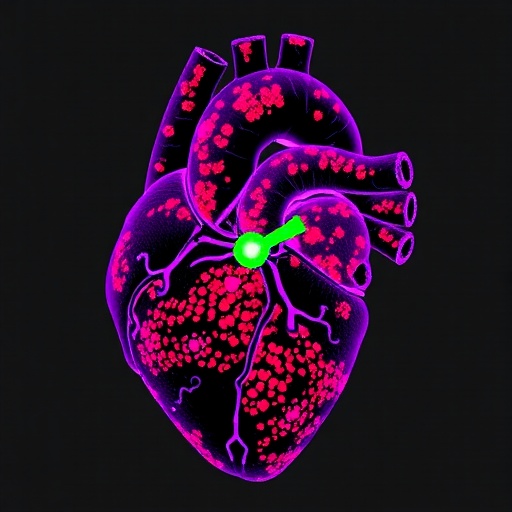In recent advancements in the realm of genetic engineering, a pivotal study has emerged that focuses on the development of knockout cardiac muscle cell lines utilizing integrase-deficient lentivirus-mediated CRISPR/Cas9 gene editing. This innovative approach is significant for researchers aiming to uncover the intricacies of cardiac muscle function and pathology. By employing a robust genetic modification technique, scientists are now better equipped to model diseases, evaluate therapeutic responses, and explore the underlying mechanisms that govern cardiac behavior.
The heart, a vital organ critical for sustaining life, is composed of specialized cardiac muscle cells known as cardiomyocytes. Given their central role in heart function, understanding the genetic determinants of these cells is crucial. Traditional methods of gene editing, however, have faced limitations, including challenges related to efficiency and specificity. The introduction of CRISPR/Cas9 technology has revolutionized the field, allowing precise alterations in the genome, which paves the way for developing knockout models that can significantly contribute to cardiovascular research.
In this innovative study, the researchers developed an integrase-deficient lentivirus to facilitate the delivery of CRISPR components into cardiac muscle cells. The choice of using a lentiviral vector is particularly noteworthy due to its ability to effectively transduce both dividing and non-dividing cells while also allowing stable integration of the gene editing machinery. This is a key factor in establishing long-lasting knockout cell lines essential for comprehensive studies on cardiac physiology and pathology.
The research centered on the systematic identification of target genes implicated in cardiomyocyte function. Through the targeted application of the CRISPR/Cas9 system, the scientists implemented precise genomic modifications that resulted in the knockout of specific genes of interest. This technique not only offered insights into gene function but also established a framework for developing disease models that closely emulate human cardiac diseases, ultimately fostering advancements in therapeutic strategies.
One of the standout facets of this research is the demonstrable efficiency of the proposed method in creating knockout lines. Various metrics indicated high knockout rates, underscoring the system’s potential as a powerful tool for cardiac research. The ability to manipulate gene expression with such precision provides researchers with the opportunity to dissect pathways that are often compromised in various cardiac conditions, including heart failure and arrhythmias.
Additionally, the integration of this CRISPR technology with a knockout strategy has considerable implications for drug testing and the exploration of novel therapeutic agents. By utilizing the engineered cardiac muscle cell lines, scientists can evaluate how drugs interact with specific genetic variations. This approach not only accelerates the drug development process but also enhances the safety and efficacy profiles of novel therapies before they advance to clinical trials.
Moreover, the study highlights the potential for this methodology to pave the way for personalized medicine. As genetic makeup varies between individuals, the ability to generate patient-specific cardiac muscle cell lines could lead to tailored treatment strategies that address unique patient needs. This personalized approach opens new avenues in treating a myriad of cardiac conditions, enabling healthcare providers to deliver more effective interventions based on individual genetic profiles.
The research team also explored ethical considerations surrounding gene editing technologies, particularly regarding potential off-target effects and long-term implications of genetic modification. By employing rigorous validation techniques, they ensured that the alterations made were specific and precise, mitigating concerns about unintended consequences that could arise from less refined approaches to gene editing.
Additionally, this study emphasizes the importance of collaboration within the scientific community. The successful development and application of integrase-deficient lentivirus-mediated CRISPR/Cas9 technologies necessitate cross-disciplinary efforts among geneticists, cardiologists, and molecular biologists. Such collaborations are vital for ensuring that findings are translated effectively from laboratory settings to clinical applications, ultimately enhancing patient care and outcomes.
Furthermore, the implications of this work extend beyond the realm of cardiac research. The methodologies and findings could be adapted and applied to other muscle types and organ systems, thus broadening the impact of this research across multiple fields of biomedicine. This versatility showcases the remarkable potential of CRISPR/Cas9 technology as a universal tool for genetic modification and exploration.
As the research landscape continues to evolve, expect to see further refinement and implementation of these advanced gene-editing techniques. The implications of successful knockout models in cardiac research will undoubtedly catalyze developments in regenerative medicine, opening doors to novel approaches in heart repair and regeneration strategies.
Such groundbreaking studies serve not only as a source of knowledge but also as an inspiration for future generations of scientists. The exploration of cardiac muscle cell lines presents fertile ground for inquiry, one that encourages the scientific pursuit of understanding the intricacies of the heart. This knowledge is invaluable, potentially leading to transformative breakthroughs in cardiovascular health.
In conclusion, the innovative work presented in the study underscores the importance of integrating cutting-edge genetic engineering techniques in cardiovascular research. By harnessing the power of the CRISPR/Cas9 system and lentiviral vectors, researchers are breaking new ground in the quest to illuminate the complexities of cardiac biology. As the field continues to advance, one can anticipate a wave of new discoveries that will propel our understanding of cardiovascular diseases and foster the development of tailored therapeutic interventions.
Through this amalgamation of skill, technology, and curiosity, the quest to unravel the mysteries of the heart takes a significant step forward. The future of cardiac research is bright, and the advancements in gene editing technology promise revolutionary changes that could lead to a healthier future for millions around the globe.
Subject of Research: Development of Knockout Cardiac Muscle Cell Lines Using Integrase-Deficient Lentivirus-Mediated CRISPR/Cas9 Gene Editing
Article Title: Development of Knockout Cardiac Muscle Cell Lines Using Integrase-Deficient Lentivirus-Mediated CRISPR/Cas9 Gene Editing
Article References:
Zhang, F., Lu, Q., Qian, X. et al. Development of Knockout Cardiac Muscle Cell Lines Using Integrase-Deficient Lentivirus-Mediated CRISPR/Cas9 Gene Editing. Biochem Genet (2025). https://doi.org/10.1007/s10528-025-11300-2
Image Credits: AI Generated
DOI: https://doi.org/10.1007/s10528-025-11300-2
Keywords: CRISPR/Cas9, cardiac muscle cell lines, gene editing, cardiovascular research, knockout models, personalized medicine, drug testing, regenerative medicine.




